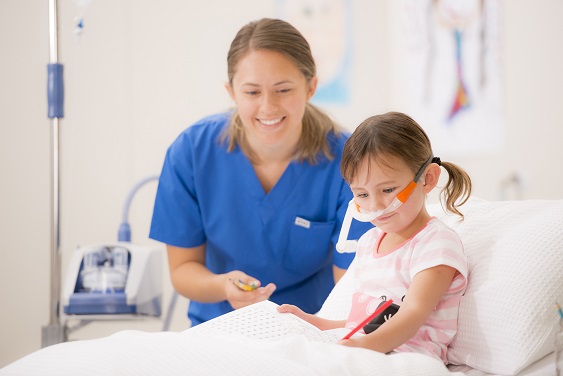
New oxygen therapy for children with acute respiratory failure
Queensland emergency medicine researchers are trialling a new device for children presenting to hospital emergency departments with life-threatening respiratory failure.
In Australia and New Zealand, acute hypoxemic respiratory failure (AHRF) in children is the most frequent reason for hospital admission and the standard treatment is offering oxygen.
Clinical Director of the Emergency department at Lady Cilento Children’s Hospital (LCCH), Dr Fiona Thomson, said approximately 20 per cent of children with AHRF could rapidly deteriorate and require assisted breathing and admission to an intensive care unit.
“We’re trialling the use of high flow nasal cannulation (HFNC) therapy as an intervention in the emergency department to see if it can prevent children being admitted to the intensive care unit,” Dr Thompson said.
HFNC is a new mode of respiratory support which delivers humidified oxygen via the nose, making it easier for patients to breathe and reducing the need for intubation and mechanical ventilation.
“In the emergency setting, we suspect HFNC could prove beneficial for children as it allows us to provide respiratory support in a matter of minutes, before they deteriorate,” she said.
“Researchers have shown the sooner we can provide respiratory support, the better the patient response.
“The simple nature of the device also means it can be safely used in local hospitals, either in emergency or on a ward, allowing families to receive treatment closer to home.”
The Emergency Medicine Foundation, with Queensland Health funding, awarded a grant for the pilot trial involving 210 children across Queensland. With further funding, the team is now looking to expand the trial nationally to include 1600 children.
New parents Julia Haddad and Simon Aramoana first noticed a rash on their six-month-old son, Essjay, and took him to LCCH emergency department. Essjay was diagnosed with bronchiolitis and placed on Ventolin to assist with his breathing. With no improvement, doctors enrolled him on the HFNC trial and began treatment.
“When Essjay’s condition deteriorated, doctors immediately put him on high flow and within a day he had improved remarkably. It was amazing – he didn’t seem like the same little boy,” Julia said.
Since this time, Essjay has been admitted to LCCH nine times with recurring bronchiolitis and placed on HFNC therapy each time.
“I much prefer the high flow therapy over intubation as there’s less risk associated with it, it acts faster and it allows kids to continue to eat, drink, talk and function normally.
“It also allowed me to interact and comfort Essjay when he was distressed, which as a parent is all you want to be able to do for your child when they are sick,” she said.
The landmark trial will see HFNC expanded from LCCH into four major metropolitan hospitals in Queensland including the Gold Coast University Hospital, Redcliffe Hospital, Ipswich Hospital and Sunshine Coast University Hospital.
This study is one of four HFNC trials, led by LCCH’s Associate Professor Andreas Schibler, which have shown HFNC therapy to be effective as non-invasive ventilation for newborns and adults with respiratory issues.
“Our previous pilot study found that infants with respiratory failure who were treated early in the emergency department with HFNC therapy, had a lower failure rate than with standard oxygen therapy – meaning they have a reduced need for intensive care admission and invasive ventilation,” Associate Professor Schibler said.
“As a result of the therapy, we’ve also seen a reduction in intubation rates for infants within intensive care from 30 per cent to around five percent of patient over the past five years.
“Through this new trial in children, we hope to achieve similar results across multiple sites so we can establish HFNC as the gold standard in paediatric care for respiratory failure.”
Photo: Courtesy Fisher & Paykel Healthcare
SHARE



